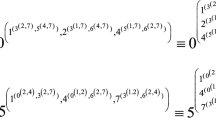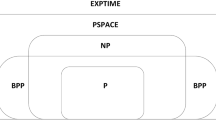Abstract
Tissue P systems with channel states are a class of parallel computing models, where the communication between two regions is regulated by a channel state, and at a computation step the state of a channel can evolve to one of the arbitrarily many states. In this work, we limit the “arbitrarily many states of a channel” to “two states of a channel”. Such a variant of P systems is called tissue P systems with flip-flop channel states (TPFFCSs). The computation power of TPFFCSs is studied. We show that TPFFCSs with arbitrarily many cells and antiport rules of length 2 are able to compute only finite sets of non-negative integers. However, TPFFCSs with two cells, antiport rules of length 3, or symport rules of length 2, or symport rules of length 1 and antiport rules of length 2 are proved to be Turing universal.
Similar content being viewed by others
References
Păun, Gh: Computing with membranes. J. Comput. Syst. Sci. 61(1), 108–143 (2000)
Martín-Vide, C., Pazos, J., Păun, Gh, Rodriguez-Paton, A.: Tissue P systems. Theor. Comput. Sci 296(2), 295–326 (2003)
Ionescu, M., Păun, Gh, Yokomori, T.: Spiking neural P systems. Fund. Inf. 71(2–3), 279–308 (2006)
Păun, Gh, Rozenberg, G., Salomaa, A. (eds.): The Oxford Handbook of Membrane Computing. Oxford University Press, New York (2010)
Alhazov, A., Freund, R., Oswald, M.: Tissue P systems with antiport rules and small numbers of symbols and cells. Lect. Notes Comput. Sci. 3572, 100–111 (2005)
Díaz-Pernil, D., Gutiérrez-Naranjo, M.A., Pérez-Jiménez, M.J., Riscos-Núñez, A.: A uniform family of tissue P system with cell division solving 3-COL in a linear time. Theor. Comput. Sci. 404(1), 76–87 (2008)
Díaz-Pernil, D., Pérez-Jiménez, M.J., Riscos-Núñez, A., Romero-Jiménez, Á.: Computational efficiency of cellular division in tissue-like membrane systems. Rom. J. Inf. Sci. Tech. 11(3), 229–241 (2008)
Păun, A., Păun, Gh: The power of communication: P systems with symport/antiport. New Generat. Comput. 20(3), 295–305 (2002)
Zhang, X., Liu, Y., Luo, B., Pan, L.: Computational power of tissue P systems for generating control languages. Inf. Sci. 278, 285–297 (2014)
Păun, A., Păun, Gh, Rozenberg, G.: Computing by communication in networks of membranes. Int. J. Found. Comput. S. 13, 779–798 (2002)
Alhazov, A., Freund, R., Leporati, A., Oswald, M., Zandron, C.: (Tissue) P systems with unit rules and energy assigned to membranes. Fund. Inf. 74(4), 391–408 (2006)
Freund, R., Oswald, M.: Tissue P systems with symport/antiport rules of one symbol are computational complete. In: Gutiérez-Naranjo, M.A., Păun, Gh., Pérez-Jiménez, M.J. (eds.), Proceedings of the European Science Foundation PESC Exploratory Workshop Cellular Computing (Complexity Aspects), Sevilla, pp. 178–187 (2005)
Song, B., Zhang, C., Pan, L.: Tissue-like P systems with evolutional symport/antiport rules. Inf. Sci. 378, 177–193 (2017)
Freund, R., Oswald, M.: Modelling grammar systems by tissue P systems working in the sequential mode. Fund. Inf. 76, 305–323 (2007)
Freund, R., Verlan, S.: A formal framework for static (tissue) P systems. Lect. Notes Comput. Sci. 4860, 271–284 (2007)
Păun, Gh, Pérez-Jiménez, M.J., Riscos-Núñez, A.: Tissue P systems with cell division. Int. J. Comput. Commun. 3(3), 295–303 (2008)
Song, B., Song, T., Pan, L.: A time-free uniform solution to Subset Sum problem by tissue P systems with cell division. Math. Struct. Comp. Sci. 27(1), 17–32 (2017)
Freund, R., Păun, Gh, Pérez-Jiménez, M.J.: Tissue P systems with channel states. Theor. Comput. Sci. 330, 101–116 (2005)
Pan, L., Păun, Gh, Song, B.: Flat maximal parallelism in P systems with promoters. Theor. Comput. Sci. 623, 83–91 (2016)
Song, B., Pérez-Jiménez, M.J., Păun, Gh, Pan, L.: Tissue P systems with channel states working in the flat maximally parallel way. IEEE T. NanoBiosci. 15(7), 645–656 (2016)
Song, B., Pan, L., Pérez-Jiménez, M.J.: Cell-like P systems with channel states and symport/antiport rules. IEEE T. NanoBiosci. 15(6), 555–566 (2016)
Rozenberg, G., Salomaa, A. (eds.): Handbook of Formal Languages, 3 vols. Springer, Berlin (1997)
Minsky, M.L.: Computation: Finite and Infinite Machines. Prentice-Hall, New Jersey (1967)
Pan, L., Pérez-Jiménez, M.J.: Computational complexity of tissue-like P systems. J. Complexity 26(3), 296–315 (2010)
Pan, L., Song, B., Valencia-Cabrera, L., Pérez-Jiménez, M.J.: The computational complexity of tissue P systems with evolutional symport/antiport rules. Complexity 3745210, 1–22 (2018)
Author information
Authors and Affiliations
Corresponding author
Additional information
The work of B. Song and L. Pan was supported by National Key Research and Development Program of China for International Science and Technology Cooperation Projects (No. 2017YFE0103900), National Natural Science Foundation of China (61320106005, 61602192, 61772214, and 61702383), China Postdoctoral Science Foundation (2016M600592 and 2017T100554), and the Innovation Scientists and Technicians Troop Construction Projects of Henan Province (154200510012). The work of Y. Wang was supported by National Natural Science Foundation of China (61472372 and 61632002) and Science and Technology Innovation Talents Henan Province (174200510012).
Rights and permissions
About this article
Cite this article
Song, B., Pan, L., Jiang, S. et al. The computation power of tissue P systems with flip-flop channel states. Int J Adv Eng Sci Appl Math 10, 213–220 (2018). https://doi.org/10.1007/s12572-018-0225-x
Published:
Issue Date:
DOI: https://doi.org/10.1007/s12572-018-0225-x




